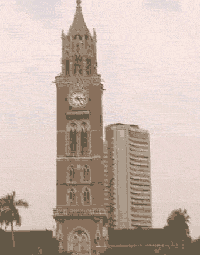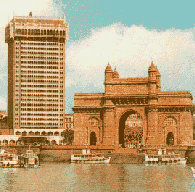| Environment Every Breath You Take
|
|||||
|
Environment • Beautiful Beasts • Paradise in the Wild • The Ocean:Conquest • A Source of Solace • Sighting the Ocean • The Ocean in Verse • Childhood Dream • Hunt for Indian Tiger
Adventure activities | ||||
From Colaba to Manori along the sea front and up to Thane along a flamingo-populated creek, the sea and wind still combine to make Mumbai habitable. One single gust probably performs a greater air-purification service for 12 million lungs than the ineffective Maharashtra Pollution Control Board could achieve in a decade... even if it were magically motivated to do so. This of course is little consolation for the Sukumarans whose lovely daughter Revathi literally died one March morning from aspiration pneumonia caused by smoke from the Deonar dumping grounds at the Chembur-Vashi link road. The Sukumars' tragedy could well be yours tomorrow. At any given time only half of BMC's work force actually works. The whole rotten edifice is involved in a flourishing dual-employment racket involving kickbacks up the line from the streets to the Corporation Head Quarters. Meanwhile, cocooned in air-conditioned homes, cars and offices, the city's aristocracy, imagining it is protected from the effects of accumulated garbage and filth, violates every development rule and generates more prodigious and unmanageable waste than the poor. To make matters worse, organochlorines in our food and air take a toll of the immune systems of both rich and poor. This makes us even more vulnerable to classless epidemics of dengue, malaria, hepatitis, HIV and gastroenteritis, which now compete with tuberculosis for pride of place as public hazard number one.
Overcoming a coughing spasm as I jog along Mumbai's pestilence-ridden streets, I wonder what the 13th century Raja Bhimdev might think of the way in which today's rulers are managing the capital he so painstakingly set up in Mahikawati (what we now call Mahim). It was inevitable of course that the thousands of fruit trees, fields and fish-yielding talaos would decline. But when I contemplate reports of mercury, chrome and arsenic squatting like toxic time-bombs in the ooze of the Thane Creek... or of lead-dust waiting to be inhaled by toddlers from the unswept gutters of Peddar Road, and Saki Naka it occurs to me that we have lost it... completely. We Mumbaikars, I realise, have made a virtue out of soiling our beds and then wallowing in them. The process of transforming the idyllic home of the Kolis into urbania began with Francis Almeida's Portuguese forces in 1508 and continued unabated when the British East India Company took charge. The infamous Mr. Nitin Gadkari, Hon'ble Minister for Urban Development, would probably have loved those politically incorrect Halcyon days, when even the token resistance of local fishing villages to "development" was crushed by brute force. Not a breath of environmentalism tainted the air then and no Shyam Chainani breathed down developers' necks. But those were days of physical, not chemical invasion. Today, hydrocarbons, pesticides, dioxins, furans and heavy metals combine with pathogens, demolitions, slum-lordism and the contractor-raj to subjugate the ordinary citizen. Solutions to Mumbai's toxic nightmare come in thick and fast from several creative sources. Architect P.K. Das suggests we honour the Koli community and resurrect Mumbai's seascapes. Social activist Minar Pimple suggests the women of Dharavi be empowered rather than the slum-lords that patronise Mantralaya. Environmentalist, Debi Goenka suggests that pedestrian plazas and improved public transport will reduce traffic congestion and air pollution more effectively than the Bandra-Worli link road and hundreds of concrete flyovers. Human rights lawyer Colin Gonsalves reminds us of the children who died from water contamination in Kalachowki and advises us to prevent diseases before trying to cure them. Why are such common sense solutions not readied? Because the authors can find no glue to cement them in joint purpose... while avarice binds the exploiters in an unholy nexus. Think of that as you look forward to a winter-long photochemical smog that is guaranteed to take your breath away.
Courtesy: Sanctuary Magazine
|
|||||
Editor: Romola Butalia (c) India Travelogue. All rights reserved. |
|||||
 SO2, NOx, SOx, Lead... straight from your car into my head. Sitting high above Chowpatty with the sea spray obliterating my view of Nariman Point I understand why the rulers of the Silhara dynasty chose to construct a temple at Walkeshwar long centuries ago. In leopard country, in the early monsoon dawn I experience the same timelessness while staring out of a rock-cave hewn by ancient forest- dwelling Buddhist communities in Kanheri, Borivli. There is an elemental quality to the monsoon that our city fathers have not yet been able to wholly ruin. I realise as I am ferried in driving rain towards Bhaucha Dhakka from the sulphur-contaminated confines of the Jawarharlal Nehru Port.
SO2, NOx, SOx, Lead... straight from your car into my head. Sitting high above Chowpatty with the sea spray obliterating my view of Nariman Point I understand why the rulers of the Silhara dynasty chose to construct a temple at Walkeshwar long centuries ago. In leopard country, in the early monsoon dawn I experience the same timelessness while staring out of a rock-cave hewn by ancient forest- dwelling Buddhist communities in Kanheri, Borivli. There is an elemental quality to the monsoon that our city fathers have not yet been able to wholly ruin. I realise as I am ferried in driving rain towards Bhaucha Dhakka from the sulphur-contaminated confines of the Jawarharlal Nehru Port.  The air outside the Taj Mahal Hotel is fat with lead, as is the air breathed in the nearby slums. And the water from gilt-edged faucets democratically delivers fecal matter, fecund with bacteria, to both high-rise buildings and pavement dwellers. Funds to prevent such wretchedness are consumed in a cycle of corruption, apathy and avarice that pollutes the purpose of society, prior to polluting its environment. Our leaders no longer lead... they plunder. Developers no longer develop... they pillage. What is worse, citizens battered by scams and betrayals seldom act... they whimper. This is at the heart of Mumbai's never-ending environmental nightmare.
The air outside the Taj Mahal Hotel is fat with lead, as is the air breathed in the nearby slums. And the water from gilt-edged faucets democratically delivers fecal matter, fecund with bacteria, to both high-rise buildings and pavement dwellers. Funds to prevent such wretchedness are consumed in a cycle of corruption, apathy and avarice that pollutes the purpose of society, prior to polluting its environment. Our leaders no longer lead... they plunder. Developers no longer develop... they pillage. What is worse, citizens battered by scams and betrayals seldom act... they whimper. This is at the heart of Mumbai's never-ending environmental nightmare.
